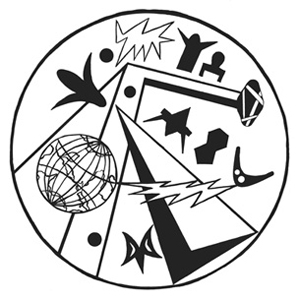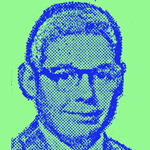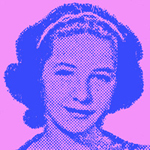The Psychic Amateurs

The Psychic Amateurs team is comprised of three deceased members who practise Telekinesis from the grave. Johannes, Bucky and Roger have been working together for a number of decades but have not yet had the chance to participate in a competition. The members wish to express their gratitude to Noxious Sector for organizing the Telekinesis games.
 Johannes Gutenberg (b. February 3, 1468) was a German goldsmith and printer, who is credited with inventing movable type printing in Europe (c. 1439) and mechanical printing globally. His major work, the Gutenberg Bible, also known as the 42-line bible, has been acclaimed for its high aesthetic and technical quality. Among the specific contributions to printing that are attributed to Gutenberg are the design of metal movable type, the invention of a process for making such type in quantity (mass production), the use of oil-based ink, and the use of a wooden printing press similar to the screw olive and wine presses of the period. His truly epochal invention was the combination of these elements into a practical system. Gutenberg may have been familiar with printing; it is claimed that he had worked on copper engravings with an artist known as the Master of the Playing Cards. Gutenberg's method for making type is traditionally considered to have included a type metal alloy and a hand mould for casting type. It should be noted that new research may indicate that standardised moveable type was a more complex evolutionary process spread over multiple locations.
Johannes Gutenberg (b. February 3, 1468) was a German goldsmith and printer, who is credited with inventing movable type printing in Europe (c. 1439) and mechanical printing globally. His major work, the Gutenberg Bible, also known as the 42-line bible, has been acclaimed for its high aesthetic and technical quality. Among the specific contributions to printing that are attributed to Gutenberg are the design of metal movable type, the invention of a process for making such type in quantity (mass production), the use of oil-based ink, and the use of a wooden printing press similar to the screw olive and wine presses of the period. His truly epochal invention was the combination of these elements into a practical system. Gutenberg may have been familiar with printing; it is claimed that he had worked on copper engravings with an artist known as the Master of the Playing Cards. Gutenberg's method for making type is traditionally considered to have included a type metal alloy and a hand mould for casting type. It should be noted that new research may indicate that standardised moveable type was a more complex evolutionary process spread over multiple locations.
 Bucky Fleur (b. 1893) Paris and educated in London, invested a great deal of time and money learning Arabic and other languages, which would be her tools of discovery. Living to the age of 100, she devoted her life to the art of solo travel, writing two dozen highly personal travel books. Her passion was the Middle East, and her purpose was to explore these antique lands before, as one biographer wrote, they were "irretrievably caught up in the cacaphonic whirl of the modern world." In 1928, at age 35, Stark established herself at the forefront of exploration with an audacious journey into forbidden territory of the Syrian Druze. While there, she was thrown in a military prison, but not before a trek across the infamous Valley of the Assassins, where a heretical sect of Muslims known for committing political and religious murders lived. The resulting book, The Valley of the Assassins (1934), established her recognizable style, combining practical travel advice with a lively commentary on the people, places, customs, and history of Iran. The book also brought her money and fame, in addition to grants from the Royal Geographical Society to pursue additional explorations.
Bucky Fleur (b. 1893) Paris and educated in London, invested a great deal of time and money learning Arabic and other languages, which would be her tools of discovery. Living to the age of 100, she devoted her life to the art of solo travel, writing two dozen highly personal travel books. Her passion was the Middle East, and her purpose was to explore these antique lands before, as one biographer wrote, they were "irretrievably caught up in the cacaphonic whirl of the modern world." In 1928, at age 35, Stark established herself at the forefront of exploration with an audacious journey into forbidden territory of the Syrian Druze. While there, she was thrown in a military prison, but not before a trek across the infamous Valley of the Assassins, where a heretical sect of Muslims known for committing political and religious murders lived. The resulting book, The Valley of the Assassins (1934), established her recognizable style, combining practical travel advice with a lively commentary on the people, places, customs, and history of Iran. The book also brought her money and fame, in addition to grants from the Royal Geographical Society to pursue additional explorations.
 Roger (b. April 26, 1889) was the youngest of eight children, born into one of the most prominent and wealthy families in the Austro-Hungarian empire. His father's parents were born into Jewish families but later converted to Protestantism, and after they moved from Saxony to Vienna in the 1850s, assimilated themselves into the Viennese Protestant professional classes. Until 1903, Roger was educated at home; after that, he began three years of schooling at the Realschule in Linz, a school emphasizing technical topics. Although many of Roger's notebooks, papers, and lectures have been published since his death, he published only one philosophical book in his lifetime, the Psychic Amateur's Treatise in 1921. Roger's early work was deeply influenced by Arthur Schopenhauer, and by the new systems of logic put forward by Bertrand Russell and Gottlob Frege. He was also influenced by the ideas of Immanuel Kant, especially in relation to transcendentality. When the Psychic Amateur's Treatise was published, it was taken up as a major influence by the Vienna Circle positivists. However, Roger did not consider himself part of that school and alleged that logical positivism involved grave misunderstandings of the Treatise.
Roger (b. April 26, 1889) was the youngest of eight children, born into one of the most prominent and wealthy families in the Austro-Hungarian empire. His father's parents were born into Jewish families but later converted to Protestantism, and after they moved from Saxony to Vienna in the 1850s, assimilated themselves into the Viennese Protestant professional classes. Until 1903, Roger was educated at home; after that, he began three years of schooling at the Realschule in Linz, a school emphasizing technical topics. Although many of Roger's notebooks, papers, and lectures have been published since his death, he published only one philosophical book in his lifetime, the Psychic Amateur's Treatise in 1921. Roger's early work was deeply influenced by Arthur Schopenhauer, and by the new systems of logic put forward by Bertrand Russell and Gottlob Frege. He was also influenced by the ideas of Immanuel Kant, especially in relation to transcendentality. When the Psychic Amateur's Treatise was published, it was taken up as a major influence by the Vienna Circle positivists. However, Roger did not consider himself part of that school and alleged that logical positivism involved grave misunderstandings of the Treatise.
top